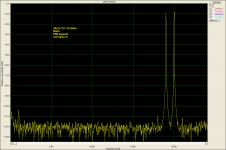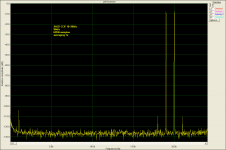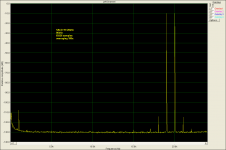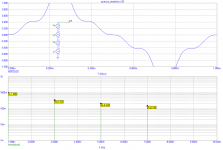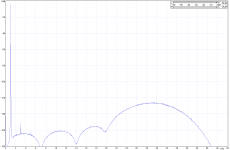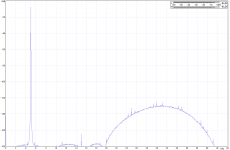Ever done any wavelet analysis?
Once you get into anything like that you have added sampling and digital processing to the process. If the issue at hand is what the DAC does to the instantaneous signal then looking at it with an inverse of the same process may well hide all you are looking for.
We still have the pending argument that most of this is inaudible leading to the how do you know, etc.
Most DAC datasheets call out a specific low pass filter in front of the analyzer to hide all of that noise.
Never done any wavelet analysis, though I am interested in it.
Yeah me too - I'm trying to get into it but a lot of it seems impenetrable. For example I bought this book only last week but its so tough going. It seems to assume vast tracts of understanding that have never impinged on my consciousness...
http://www.amazon.com/Wavelet-Tour-Signal-Processing-Third/dp/0123743702/ref=sr_1_1?s=books&ie=UTF8&qid=1318917936&sr=1-1
Fortunately here in China its a whole lot cheaper than the Amazon price 🙂
If the issue at hand is what the DAC does to the instantaneous signal then looking at it with an inverse of the same process may well hide all you are looking for.
Well the rogue process I think here (hypothesize) is the noise shaper. Wavelets don't rely on that do they?
The other alternative I've considered is analog subtraction of the output of a multibit dac from that from an S-D DAC then analysing the residual. Kinda like the Hafler amplifier test, but on a DAC.
I think that the SIGNIFICANT difference in risetime between SACD and CD is one of the keys to increased fidelity.
You may be aware of this, but digital sampling is simply not valid without that low pass filter. It's called a reconstruction filter in some circles, and it is a non-optional part of the system. The definition of digital sampling, based on Nyquist-Shannon sampling theorem, basically requires that you have a low pass between the original analog signal and the A/D, as well as another low pass between the DAC and the final analog recreation. Neither filter is optional.Most DAC datasheets call out a specific low pass filter in front of the analyzer to hide all of that noise.
I may be reading too much into your comments, but you seem to imply that the noise coming out of the DAC is somehow indicative of a real problem that is being masked by the low pass ahead of the analyzer. My point is that you can't skip the low pass and have a valid digital playback system. You simply do not get the original (albeit bandlimited) analog signal back without the low pass.
If you weren't trying to imply that this noise is significant, then my apologies for misunderstanding.
I think that the SIGNIFICANT difference in risetime between SACD and CD is one of the keys to increased fidelity.
And when go go further you come back to analog - sampling rate is infinite ...
By the way, in the beginning of digital recording / reproduction they prefered the delta-sigma convertrs (1 BIT) in recording studios because of its better performance.
It's time to reveal an important fact about 19+20kHz IM measurements I showed yesterday. Yes, it is Marantz 7001. Yes, the converter is CS4397. BUT - in DSD mode. This is the key to spectral purity of the plots. In CD mode, the result is worse and we can see digital artifacts in FFT measurement, done with same resolution.
For once again, all 3 plots shown with text description added. The slightly smaller amplitude of spectral components in the last plot is a result of slightly different setting of the input divider of the measuring system, this measurement was taken some time before the 2 other plots.
Regarding SACD - yes, I think the short rise time and no ringing is very important. But same importance, IMO, is the spectral purity of output signal in audio band. The ultrasound noise does not matter.
Now, about time and frequency domains. Yes, the FFT amplitude spectrum cannot describe the signal completely. We may have 2 signals different in time domain with absolutely same spectra. We would need to add phase spectrum to get the whole description of the signal.
For once again, all 3 plots shown with text description added. The slightly smaller amplitude of spectral components in the last plot is a result of slightly different setting of the input divider of the measuring system, this measurement was taken some time before the 2 other plots.
Regarding SACD - yes, I think the short rise time and no ringing is very important. But same importance, IMO, is the spectral purity of output signal in audio band. The ultrasound noise does not matter.
Now, about time and frequency domains. Yes, the FFT amplitude spectrum cannot describe the signal completely. We may have 2 signals different in time domain with absolutely same spectra. We would need to add phase spectrum to get the whole description of the signal.
Attachments
Last edited:
As you could feed the normal cd wave through a buffer and alter its rise time, I dont see how the SACD rise time can have an effect on fidelity.
I did not get your remark, it is not about "buffering" CD, but the fact that CD must sharply cut everything above 22kHz. This sharp cut is an effect to fidelity. As well as low number of bits.
Sorry, I presume the plots shown in 16773 are 1kHz square waves that have been digitised and output, then the faster rise time would equate to better transients, IMO
This is a rather misleading comment. CD is limited to 20 kHz or 22.05 kHz maximum. Thus, there is an understood limit to the rise time. Many SACD recordings are also filtered with the same 20 kHz low pass, so the raw potential of the medium is a bit of marketing fluff.I did not get your remark, it is not about "buffering" CD, but the fact that CD must sharply cut everything above 22kHz. This sharp cut is an effect to fidelity. As well as low number of bits.
I was told that early SACD releases were entirely under Sony's control, and they selected recordings that were better than most, plus they bandlimited the audio extremely on input and output. Now that anyone can buy an SACD recorder, I assume it may be possible to attain higher bandwidth without Sony having a say-so. But it still depends upon the actual analog filtering stages on the input and output of the SACD recorder. Where does one find specifications for this?
All the same, SACD is severely limited in its slew rate, due to the fact that it can only rise or fall one step per sample. Thus, I am curious as to the maximum output slew rate attainable with SACD. I assume that the peak-to-peak voltage output of an SACD analog output is in the same ball park as typical CD players.
Now, about time and frequency domains. Yes, the FFT amplitude spectrum cannot describe the signal completely. We may have 2 signals different in time domain with absolutely same spectra. We would need to add phase spectrum to get the whole description of the signal.
With an amplifier (assuming someone didn't build in a delay line)? I don't think so.
the reconstruction filter should have a equal or higher slope than the order of the noise shaping
for SACD this means a 5th or 6th order low pass, Sony's original spec of 100 kHz Fc apparently let too much of the rising noise through (SACD noise just makes its 120 dB S/N spec @20 kHz then heads for +6 dB fs ~ 1.4 MHz - you can see the start of the rise in the SACD player output with a 192 kHz ADC sound card), Sony now officially recommends a 50 kHz Fc
if your filter corner frequency is way below the shaper corner frequency you may be able to get by with a little lower order filtering
but the principle is basic - know the DAC output spectrum, filter as appropriate for that spectrum, if you want to cut corners you must know your system's tolerance for out of band signals
op amp DAC I/V should have a feedback C for a 1st order pole right up front - even multibit DAC noise shapers are higher order so an additional biquad is the minimum anyone should try
we will now probably get reprise of our Guru's disdain for low pass filters, arguments that 200 kHz fc is required
I think part of those concerns is with 1st order filters - way "droopy", if you chain too many in your system you can get attenuation at 20 kHz
if you use Butterworth or other higher order alignment with good frequency flatness up to 20 kHz I don' think there is much audible damage done when the filter fc is above ~ 40 kHz
of course doing decent 5,6 order filtering of differential DAC outputs with extended foil polystyrene 1% caps, really good op amps will run to US$ 10-20 per channel
for SACD this means a 5th or 6th order low pass, Sony's original spec of 100 kHz Fc apparently let too much of the rising noise through (SACD noise just makes its 120 dB S/N spec @20 kHz then heads for +6 dB fs ~ 1.4 MHz - you can see the start of the rise in the SACD player output with a 192 kHz ADC sound card), Sony now officially recommends a 50 kHz Fc
if your filter corner frequency is way below the shaper corner frequency you may be able to get by with a little lower order filtering
but the principle is basic - know the DAC output spectrum, filter as appropriate for that spectrum, if you want to cut corners you must know your system's tolerance for out of band signals
op amp DAC I/V should have a feedback C for a 1st order pole right up front - even multibit DAC noise shapers are higher order so an additional biquad is the minimum anyone should try
we will now probably get reprise of our Guru's disdain for low pass filters, arguments that 200 kHz fc is required
I think part of those concerns is with 1st order filters - way "droopy", if you chain too many in your system you can get attenuation at 20 kHz
if you use Butterworth or other higher order alignment with good frequency flatness up to 20 kHz I don' think there is much audible damage done when the filter fc is above ~ 40 kHz
of course doing decent 5,6 order filtering of differential DAC outputs with extended foil polystyrene 1% caps, really good op amps will run to US$ 10-20 per channel
Last edited:
With an amplifier (assuming someone didn't build in a delay line)? I don't think so.
Here you are, please. Amplitude spectrum has no "chance" to guess phase of individual harmonics.
Attachments
All the same, SACD is severely limited in its slew rate, due to the fact that it can only rise or fall one step per sample. Thus, I am curious as to the maximum output slew rate attainable with SACD. I assume that the peak-to-peak voltage output of an SACD analog output is in the same ball park as typical CD players.
I am sorry, we have lot of measurements. It is impossible to participate too long time in never-ending discussions. The rise time of my CD player in SACD mode is about 7 microseconds (even for full scale amplitude). I do not know if it makes much sense to make new and new measurements to persuade someone. Time is money - I am not retired yet. We also have some interesting DSD analysis - please forget old modulators.
Attachments
I think Sy's point is that reasonable amplifiers don't shuffle the phase of signal components in such a major way
it can be handy decerning the fraction of PIM in IMD peaks to examine relative phase asssociated with those bins and the stimulus
it can be handy decerning the fraction of PIM in IMD peaks to examine relative phase asssociated with those bins and the stimulus
PMA said:It is impossible to participate too long time in never-ending discussions.
I hear ya. Thanks for the posting this.
I think Sy's point is that reasonable amplifiers don't shuffle the phase of signal components in such a major way
Yes, what he's got there is several delay lines. Amps don't do that. They are minimum phase. Speakers do, however.
I may be reading too much into your comments, but you seem to imply that the noise coming out of the DAC is somehow indicative of a real problem that is being masked by the low pass ahead of the analyzer. My point is that you can't skip the low pass and have a valid digital playback system. You simply do not get the original (albeit bandlimited) analog signal back without the low pass.
If you weren't trying to imply that this noise is significant, then my apologies for misunderstanding.
The remark about he low pass filter relates to the measurement conditions on the data sheet. They usually call out a 20 KHz low pass filter to remove the ultrasonics that the meter reads but are "inaudible".
Here is an app note specific to the issue we are discussing: http://www.ti.com/lit/an/sbaa055/sbaa055.pdf We should all read it before continuing so we may all use similar terms.
- Status
- Not open for further replies.
- Home
- Member Areas
- The Lounge
- John Curl's Blowtorch preamplifier part II
